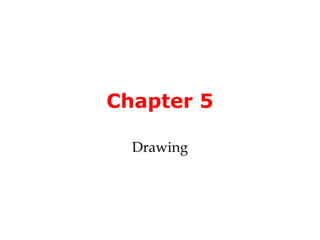
Chapter5
- 1. Chapter 5 Drawing
- 3. Two-Dimensional Art • Drawing • Painting • Printmaking • Imaging: Photography, Film, Video, and Digital Arts
- 4. Drawing . . . is the necessary beginning of everything in art, and not having it, one has nothing. –Giorgio Vasari
- 5. Drawing • The most basic of all the visual arts • The most common support is monochromatic paper or parchment. But, drawing can be found on a large variety of different surfaces. • Drawing - the result of implement running over a surface and leaving some trace of this gesture • Support - the surface • Monochromatic - one color • Linear - made of lines
- 6. DRAWING CATAGORIES 1. Sketches 2. Plans 3. Fully developed works of art
- 7. DRAWING MATERIALS Dry Media Wet Media
- 8. Dry Media Silverpoint • Uses a ground of bone or chalk mixed with gum, water and pigment • Drag a silver tipped instrument over the surface, and the particles stick to the ground. • To make an area darker you have to use cross hatching. • Very delicate in appearance
- 10. Pencil • Most traditional media • Replaced silverpoint • Capable of creating a wide range of effects History: • Came into use in the 1500s • Mass produced pencils invented in late eighteenth century • Uses a thin rod of graphite encased in wood or paper • The graphite is ground to dust, mixed with clay, and baked. • The more clay that is added to the mixture, the harder the pencil.
- 13. Pencil Figure 5.6, p.109: ADRIAN PIPER. Self-Portrait Exaggerating My Negroid Features (1981). Pencil on paper. 10” x 8”.
- 14. Charcoal • Has a long history • Used by prehistoric man on cave walls! • Charcoal is burnt pieces of wood or bone. • Now charcoal is made from controlled charring of special hardwoods. • Charcoals range from hard to soft. • Can be easily smudged or rubbed • Shows the surface of the paper • Needs to be fixed with varnish, or will rub off
- 15. Charcoal Figure 5.8, p.110: KÄTHE KOLLWITZ. Self-Portrait (1924). Charcoal. 18-3/4” x 25”.
- 20. Charcoal Figure 5.9, p.111: CLAUDIO BRAVO. Package (1969). Charcoal, pastel, and sanguine. 30-7⁄8” x 22-1⁄2”.
- 23. Chalk and Pastel • Chalk and pastel are very similar to charcoal. • The compositions of the media differ. • Created by combining pigments and a binder – such as gum arabic and then shaped into a workable stick • Relatively young, only introduced to France in the 1400s. • Available in many colors – Ocher - dark yellow that comes from iron oxide in some clays – Umber - yellowish or reddish brown color that comes from earth containing oxides or manganese and iron – Sanguine - a “earthy” red color
- 24. Chalk and Pastel Figure 5.10, p.111: MICHELANGELO. Studies for The Libyan Sybil (1510–1511). Red chalk. 11-3⁄8” x 8-3⁄8”.
- 26. Crayon • Strictly defined, the term crayon includes any drawing material in stick form (This can include charcoal, chalk, and pastel, plus wax implements.) • Conte Crayon is one of the most popular commercially manufactured crayons. • Wax crayons combine ground pigment with wax as their binder. – They are less apt to smudge.
- 27. Fluid Media • Pen and Ink • Pen and Wash • Brush and Ink • Brush and Wash
- 28. Fluid Media • The primary fluid medium used in drawing is ink. • Instruments used with ink are primarily pen and brush. • Ink has been used for thousands of years. • Egyptians used it on papyrus. • Ancient people made ink from dyes of plants, squid, and octopus. • Oldest known ink is India or China ink – Used in calligraphy – Made of carbon black and water
- 31. Pen and Ink • Used since ancient times • Earliest were hollow reeds • Quills, plucked from live birds, were used in the Middle Ages. • Replaced in the nineteenth century with mass produced metal nib, which is slipped into a stylus. – Many artists still use a these today.
- 32. Pen and Wash Figure 5.21, p.116: GIOVANNI BATTISTA TIEPOLO. Hagar and Ishmael in the Wilderness (c. 1725–1735). Pen, brush and brown ink, and wash, over sketch in black chalk. 16-1⁄2” x 11-1⁄8”.
- 33. Pen and Wash Wash - diluted ink that is applied with brush • Often combined with fine clear lines of pure ink to provide tonal emphasis • The use of a wash allows for a tonal emphasis, not visible in pen-and-ink drawings.
- 34. Brush and Ink • Extremely versatile • Brushes come in a wide variety of materials, textures, and shapes. – These create different effects.
- 36. Cartoons • Cartoon - derived from the Italian word cartone meaning paper • Originally referred to full-scale preliminary drawings done on paper for projects such as fresco paintings, stained glass, or tapestries. • In 1843, the definition was expanded to what we know now, when a parody of fresco cartoons which were submitted for decoration of the House of Parliaments, appeared in an English magazine. • Modern cartoons rely on caricature.
- 37. Figure 5.24, p.118: HONORÉ DAUMIER. Counsel for the Defense (the Advocate) (1862-1865). Pen and ink, charcoal, crayon, gouache, and watercolor. 20⅜" × 23¾".
- 41. New Approaches to Drawing Drawing displays endless versatility in: • Purpose • Media • Technique